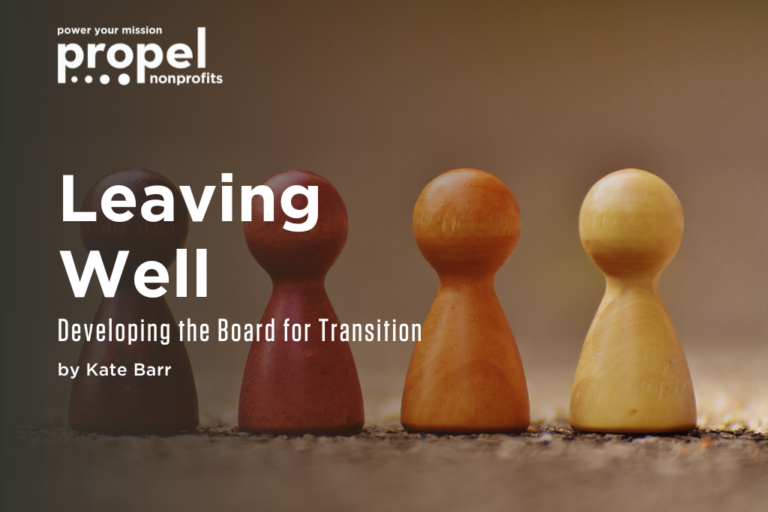Leaving Well: Developing the Board for Transition

In my first post in this series, I proposed three key lessons learned from my research and many conversations with outgoing and incoming nonprofit leaders:
- Knowing when it was the right time,
- Organizational readiness, and
- Preparing the board to change with a new leader.
Most of what has been written for or about boards related to leadership transition has focused on succession planning, but not on board readiness itself. The board of directors is a key player at a nonprofit, and their role, activities, relationships, and board culture matter – a lot.
As a source of guidance and training for nonprofits on board governance, we take the role of the board seriously for ourselves, too. We’re not immune to the dynamics that can occur at nonprofits. For example, it is common to take things for granted and to develop patterns and practices that work well for a period of time. If things are going well, why change what you’re doing? As nonprofit leaders, we know change is inevitable and constant, and we need to be prepared. “The way we do things” needs to be revisited so boards and executive directors don’t lose focus by simply “going with the flow.”
Similarly, when an organization has a longtime leader, it’s easy for the relationship between a board and an executive director to get comfortable and for things to roll along. This might lead to avoiding some necessary conversations and result in board members who don’t know how to work together.
As part of my goal to leave well, I have been working with the board in hopes that we don’t fall into these common patterns. A leadership transition is a big change. The board and I have asked ourselves: what have been the board’s practices and governing style, and how will these be understood, developed, and prepared for action next year?
Here’s how the Propel Board and I have approached this transition together:
Building Relationships
To ensure Propel was ready for this change, the Propel Board, with leadership from the Governance Committee, has devoted time over the last couple of years to extensive conversations about their purpose, the ecosystem in which we operate, and the culture of the board. Those discussions resulted in:
- New practices at board meetings to be more intentional about the relationships among board members,
- Opportunities to make more connections and share learning with staff members, and
- Easing off the “packed agenda” treadmill and creating space for more meaningful meetings.
Board Recruitment
Board recruiting reflected the preparation process, too. Discussions with prospective board members for the last two-plus years have included the upcoming transition. Those members knew when they joined the board that there would be a transition during their term. I read a study that interviewed board members who had recently completed a leadership transition, and one insight jumped out for me. When asked for advice they would give to others, one board member said that they learned that managing a transition starts with board recruitment, not when the executive transition is announced. He elaborated that the transition process needs board members that are energized, bring a breadth of perspectives and connections, and are focused on the organization and its future and rather than just their relationship with the outgoing leader.
Succession Planning
The topic of succession planning is a source of tension for some nonprofits with both the board and the executive director hesitant or reluctant to raise the question. In fact, numerous research studies report that fewer than 25% of nonprofits have a succession plan of any kind. This has not been the case with Propel; the question of succession planning and preparation has been a topic in my annual review for at least ten years. I encourage every nonprofit to normalize this discussion.
The succession plan for my position was used as the guide for creating two committees:
- A transition committee to manage the full process, including communications, staff input and support, and to work with the new leader.
- A search committee with a more focused role to work with the search firm on the selection of the new leader.
One other finding from studies of executive transitions is that some boards consider their work on the transition to be complete once a new leader has been hired. The Propel Board Transition Committee will continue with onboarding, orientation, and support for the new leader well beyond their hire date. During an executive leadership transition, boards are called upon to step up their engagement, which also means stepping up the time commitment. I am so grateful for the members of these committees and the work they have been doing on behalf of Propel.
At their most recent meeting, the Propel Board spent time reflecting on two questions:
- What do you expect to be different for the organization, and the board, with a new President & CEO?
- How will the board need to show up to partner with the new President & CEO?
Here are a few of the reflections that illustrate the path the board has been on in their own readiness and preparation:
- We need to be flexible and adaptable to what the new President & CEO needs and create space for the new leader to come into the community with us in an authentic way.
- We acknowledge that things will be different, and staff will really be experiencing a dynamic of change.
- Our role is to build genuine trust and relationships as soon as possible to give the new President & CEO the freedom to make decisions and know the board has their back. We should strive to be vulnerable with each other so we can develop relationships.
Board and Executive Director Relationships
One of Propel’s core principles is to be mutual and trusted partners with the nonprofits we work with: with partners, supporters, and with our colleagues, including the staff and board. An effective relationship for an executive director with their board is the essence of a mutual and trusted partnership. I am grateful for this partnership with the Propel Board, with a special shoutout to Sarah Clyne and Sean Kershaw, the current and past board chairs of Propel.
I’ll add that the partnership between the board chair and executive director is foundational for healthy governing, and I’ll recommend that our new President & CEO and board chair read this insightful post by Kabo Yang and Sindiswa Georgiades from Propel’s Strategic Services team which includes wisdom like this: “Trust is the cornerstone in any board chair/executive director relationship; trust brings limitless possibilities in aligning the strategic and tactical efforts of an organization.”
Related Resources
Emergency Succession Plan Template
This 2-part template was designed by Propel Nonprofits’ to serve as a narrative guide to help nonprofit leaders craft an…
Board Roles & Responsibilities
Legal compliance and financial oversight are certainly on the list of board responsibilities, but they’re not enough for effective governance….

